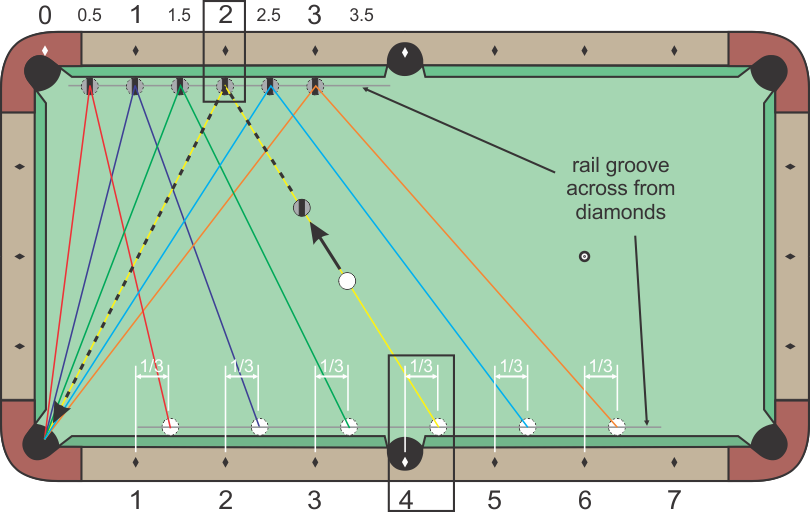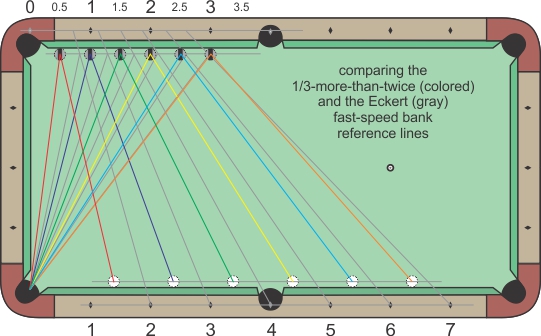What is a good system for aiming fast-speed bank shots?
The 1/3-more-than-twice bank shot aiming system described in the following articles and videos works well for sliding banks resulting from fast speed or the OB being close to the rail: “Fast Speed Banks” (BD, July, 2013) and “HAPS – Part VIII: Bank Shots” (BD, June, 2015). It works well for banks of any speed if the OB is close to the banking cushion (where it doesn’t have time or distance to develop forward roll). Here’s a diagram from the article illustrating how it works:

And here are video demonstrations, the last from Vol. III of How to Aim Pool Shots (HAPS):
The aim always originates 1/3 of a diamond above the standard 2-to-1 mirror system, measured across from the diamonds in the rail groove. It can be referred to as the “(2x + 1/3) to x” or “1/3-more-than-twice system. See the article and the video above for examples of how it is applied. The system is also described and demonstrated in “VEPS GEMS – Part V: Banks and Kicks” (BD, May, 2010). Here’s the diagram from the article that illustrates how the adjustment works. The exact amount of adjustment needed will vary with conditions and the angle of the bank, but 1/3 of a diamond is a good general benchmark reference.
A more-accurate rail-groove system for aiming sliding-ball banks is the twice-plus-tenths system.
An alternative to the 1/3-more-than-twice system, which measures everything relative to the rail grooves across from the diamonds, is the 1-more-than-twice system, which instead measures everything through the diamonds. This system requires adjustments, but it might be preferred by some people.
In addition to being able to use the aiming systems above, there are advantages to using fast speed with bank shots. For more info, see: advantages of fast speed.
An alternative to the 1/3-more-than-twice “(2x + 1/3) to x” system is a through-diamond system described in the following video: Eckert’s bank shot reference lines. It can be described concisely as the “2x-to-3/4x through-diamond system” as opposed to the “(2x+1/3)-to-x rail-groove system.” Both this system and the system above are described and illustrated in detail in: “Fast Speed Banks” (BD, July, 2013). They actually agree fairly well in the resulting aim, except for very-large-angle banks. Another way to interpret the Eckert system, is the “8/3x to x” or “x to 3/8x” system (by dividing the “2x to 3/4x” numbers by 2). This implies that the aim point on the banking rail (3/8x) is between 25% (1/4) and 50% (1/2) of the distance from the target pocket as the distance on the adjacent rail (x). This provides an easy way to visualize fast-speed banks. When the aim is correct, the aim point on the banking rail is exactly between 50% (1/2) and 25% (1/4) of the distance from the pocket on the opposite rail, which is very easy to visualize without any diamond counting or math. You could also just multiply the diamond distance on the near rail by 3/8 or 0.375 (approximately 0.4).
The following illustration compares the two systems. The systems provide very close to the same lines of aim for small-to-medium-angle banks. At larger bank angles, above the (5+1/3)-to-2.5 line, the “1/3-more than twice” system aim will tend to make the ball bank a little short of target (in which case you can make a small adjustment).

Dr. Dave keeps this site commercial free, with no ads. If you appreciate the free resources, please consider making a one-time or monthly donation to show your support:
